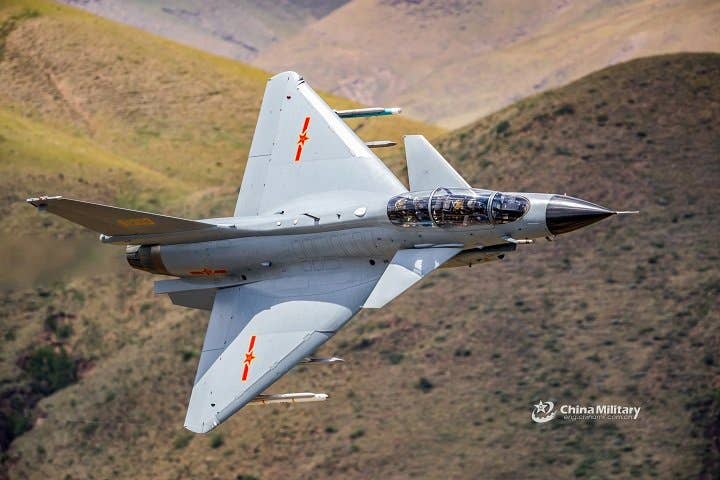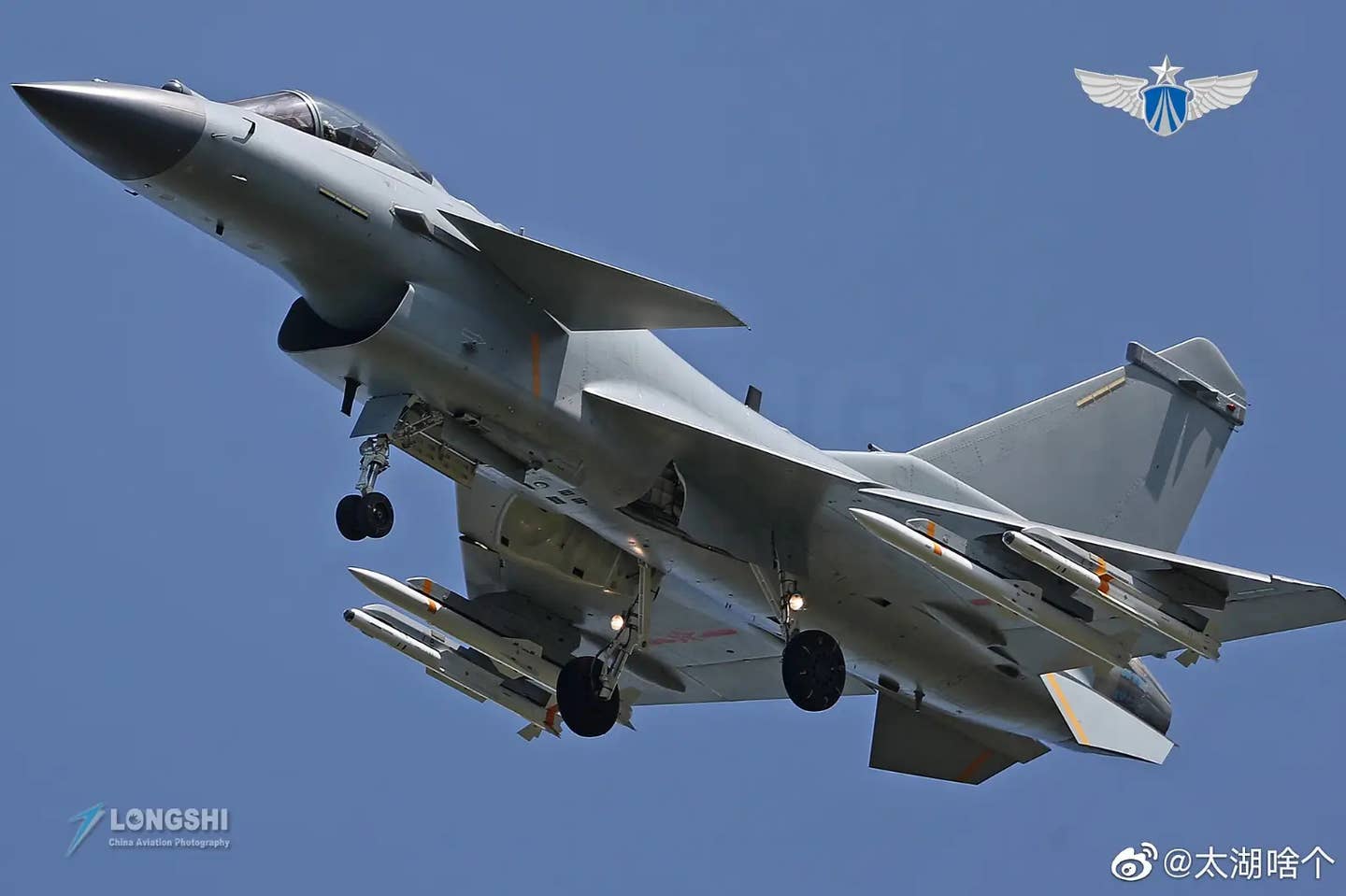China put out a video montage of the Chengdu J-10 Vigorous Dragon in March to mark the 25 years of service of the most revolutionary indigenously developed fourth-generation fighter jet, which remains the mainstay of the country’s air power.
Advertisement
Chinese state-owned media outlet Global Times released a 53-second video featuring various J-10s performing aerial combat maneuvers and formations, refueling, firing missiles, and launching flares. The video seemed to be based on the theme of Top Gun cinematic trailers.
The J-10 represents a radical step ahead in China’s journey in indigenous fighter production because, before its rise, China’s inventory of fighter jets mainly comprised Soviet-made aircraft and license-built versions of Soviet-origin platforms.
China began developmental work on the J-10 in 1984, shortly after the United States and the Soviet Union introduced F-16 Fighting Falcon and Mikoyan MiG-29 in 1978 and 1982, respectively.
The J-10 eventually proved China’s ability to produce an indigenous and fourth-generation fighter equivalent of the US and Soviet-origin fighters.
The J-10 was initially meant to replace the J-7 fighter and Q-5 attack aircraft, and therefore, it became the standard multirole fighter of the People’s Liberation Army (PLA) Air Force.
Advertisement
The J-10 Vigorous Dragon
The J-10 was designed and built by the Chengdu Aircraft Corporation (CAC). The early developmental work on the aircraft was slow.
The design designated as the J-9VI or J-9B, upon which the J-10 fighter was based, was decided upon in 1986. However, a full-size wooden mock-up of the aircraft was completed in 1991.
There were also some problems with the J-10’s planned WS-10 engine, which almost derailed the entire project, according to Chinese aerospace observer and author, Andreas Rupprecht’s book, Modern Chinese Warplanes: Chinese Air Force – Aircraft and Units.
Perhaps, therefore, several of the J-10 fighters ended up using the Soviet-made Saturn-Lyulka AL-31 engines. However, this also led the Chinese designer to rethink the J-10’s design to accommodate the new engine.
The first J-10 prototype was completed in June 1997, with the aircraft taking to the skies for the first time on March 23, 1998.
While the J-10 fighter is China’s most successful indigenous fighter jet, reports also highlight the possible connection between Israel Aerospace Industries and CAC during China’s developmental work on J-10.
According to several accounts, Israelis shared secret information with CAC about the US-funded LAVI, the Israeli fourth-generation fighter jet with a similar configuration developed in the 1980s, but could not get past the prototype stage because of the halt in US funding.
Advertisement

The LAVI, in turn, was based heavily on US technology, including some employed in the Lockheed Martin F-16 fighter. Therefore, the J-10 may have some US-origin technology, such as avionics, advanced composite materials, and flight control specification.
Also, the Israeli influence on the J-10’s design is apparent in the latter’s close-coupled, canard-delta arrangement. However, there are also some notable differences between LAVI and J-10, such as the latter’s larger size, wing planform, and the distance between the canard and the wing.

For instance, China could not access LAVI’s compact Pratt & Whitney PW1120 turbofan engine. It lacked the capability for large-scale production of lightweight composite components. Therefore the J-10’s fuselage had to be lengthened by two meters to accommodate the Soviet-made AL-31F turbofan engine, resulting in an 11.75-ton jet.

Apart from the aerodynamic design, the J-10’s Type 1473 pulse doppler fire control radar is also said to be based on the Israeli EL/M 2035 doppler radar intended for its canceled LAVI fighter jet.
The Type 1473 radar, developed by the Nanjing Research Institute of Electronic Technology (NRIET), is said to have a maximum detection range of around 100-120 kilometers, according to various reports.
Most early J-10A aircraft carried China’s domestically produced PL-8 short-range infrared-guided air-to-air missile (AAM), the licensed-built version of the Israeli Python-3 missile. The aircraft also carried the PL-11 semi-active guided medium-range AAMs, which were later replaced by the active radar-guided PL-12 medium-range AAM.
Recently, the PL-8 and PL-12 on PLA Air Force’s (PLAAF’s) J-10s have been replaced by the PL-10 advanced short-range missiles and active radar-guided PL-15 missiles.
The J-10 can also carry a wide range of air-to-ground and anti-ship weaponry, such as the LS-500J precision-guided bombs, the newer GB1/TG500, and its targeting pod.
Apart from the J-10A and the land-based naval J-10AH variant, China also developed a tandem two-seat variant of the aircraft called the J-10AS or the J-10ASH for maritime use. The two-seater J-10AS variant made its maiden flight in 2003 and was certified in late 2005, entering service with the PLAAF shortly after that.

The twin-seater J-10 has an enlarged dorsal spine that contains some of the aircraft’s electronics.
The next series-production version of the J-10, the J-10B, was first disclosed in March 2009, powered by the Saturn-Lyuika AL-3FN Series 3 engine that provides increased thrust than the older models.
The J-10B features infrared search and track (IRST) and laser rangefinder ball in front of the canopy, an updated glass cockpit with three large color multi-functional displays (MFDs), a helmet-mounted display, and a wide-angle holographic head-up display (HUD).
Advertisement

In addition, the J-10B also has the new X-band Passive Electronically Scanned Array (PESA) radar under its re-contoured radome, developed by the No. 607 Institute and believed to be the first of its kind ever produced for a Chinese fighter.
Rupprecht suggests that the J-10B would have been equipped with an Active Electronically Scanned Array (AESA) radar developed by the 14th Institute. However, it was not ready in time. There were a series of delays in the development of this aircraft, resulting in its serial production not beginning until mid-2013.
Soon after the serial production of J-10B began, the latest J-10C variant was also seen for the first time in late December 2013.

The J-10C was equipped with an AESA radar, and from around 2019 onward, the J-10Cs have also been fitted with the indigenously developed Shenyang WS-10 engine, China’s first successful turbofan fighter engine.
J-10 Revolutionized China’s Aviation Sector
The success of the J-10 stimulated innovation in China’s domestic fighter jet technology, which included engines, aircraft sensors, and radar capabilities and is therefore considered a pivotal point in the progress of China’s aviation sector.
Eventually, China went on to develop and produce its most advanced in-service fighter jet, the J-20, also known as Mighty Dragon. It is a fifth-generation stealth fighter, also developed by CAC. It was first revealed in December 2010, shortly before its first flight in January 2011.

The PLAAF commissioned the J-20 in September 2017, and somewhere between 70-150 airframes are believed to have been produced. Reports also suggest the possibility of a new J-20B variant, which could have an array of enhanced capabilities.
Regarding the J-10, the new Shenyang J-31/J-35/FC-31 medium-weight stealth fighter program could be considered China’s most significant ongoing fighter program. Reports suggest this platform would replace the PLA Air Force’s J-10s in the future.
However, the navalized variant of the aircraft for the PLA Navy seems to be making the most visible progress.
In addition, China appears to be working on a sixth-generation manned fighter equivalent of the US Air Force’s Next Generation Air Dominance (NGAD) program. While much is unknown about this aircraft, there are indications that it could feature a tailless configuration.